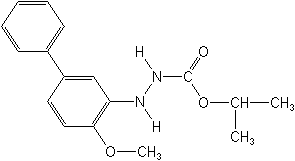-
Common NameBifenazate
-
中文通用名联苯肼酯
-
IUPACisopropyl 3-(4-methoxybiphenyl-3-yl)carbazate
-
CAS1-methylethyl 2-(4-methoxy[1,1'-biphenyl]-3-yl)hydrazinecarboxylate
-
CAS No.149877-41-8
-
Molecular FormulaC17H20N2O3
-
Molecular Structure
-
Category
-
ActivityAcaricide/Miticide
Bifenazate is a contact acaricide active against all life stages of spider-, red- and grass mites, including eggs. It has a rapid knockdown effect (usually less than 3 days) and residual activity on the leaf lasting up to 4 weeks. The product’s activity is not temperature-dependant - control is not reduced at low temperatures. It doesn't control rust-, flat- or broad-mites.
Studies to date suggest bifenazate acts as a GABA (gamma-aminobutyric acid) antagonist in the peripheral nervous system at the neuromuscular synapse in insects. GABA is an amino acid present in the nervous system of insects. Bifenazate blocks the GABA-activated chloride channels, resulting in over-excitation of the peripheral nervous systems of susceptible pests. This mode of action is reported to be unique among acaricides, which suggests the product could play an important future role in mite resistance management strategies.
Bifenazate is active against mites resistant to standard and recently introduced acaricides. It is safe to predatory Stigmaeid mites (including Zetzellia mali - see ESA 2002), Phytoseid mites (Typhlodromus accidentalis, T pyri, Phytoseiulus persimilis, Amblyseius fallacis) and beneficial insects such as green lacewings (Chrysoperla carnea). Uniroyal recommends it for use in IPM programmes.
Studies at the University of Florida in the late 1990's identified a possible emergence of resistance to abamectin in two-spotted mites in strawberries; bifenazate may provide an alternative treatment.
In field trials, no phytotoxicity has been reported, even at rates much greater than those recommended. -
CropUseCropUses:
acerola, almonds, apples, apricots, atemoya, avocados, bananas, carambola, cherries, citrus, cotton, cucurbits, fruiting vegetables, guava, hops, jackfruits, key lime, kumquat, longan, lychee, mamey sapote, mangos, nectarines, okra, papaya, passion fruits, peaches, pears, peppermints, pistachios, plantain, plums, potatoes, pummelos, sapodillas, spearmints, stone fruits, strawberries, sugar apples, Tahiti lime, tea, tree nuts, vines, watermelons, wax jambu, white sapote
300-600 g ai/ha
-
PremixFenbutatin+Bifenazate
Clofentezine+Bifenazate
Bifenazate+Spirotetramat
Bifenazate+Etoxazole
-
Physical PropertiesMolecular weight:300.4; Physical form:White, odourless crystals; ( is a beige solid). Density:1.31; Composition:Tech. is >90% . Melting point:120-124 °C; Flash point:110 °C; Vapour pressure:<1 × 10-2 (25 °C); Henry constant:1 × 10-3 Pa m3 mol-1; Partition coefficient(n-octanol and water):logP = 3.4 (25 °C, 7); Solubility:In water 3.76 /l (20 °C).; Stability:Stable for >1 y at 20 °C and 50% 50 (hydrolysis) 20 h (25 °C, 7); 50 (photolysis) 17 h (25 °C, 5).;
-
ToxicologyOral:Acute oral
50 for rats >5000 / . Percutaneous:Acute percutaneous 50 for rats >2000 /kg. Not a skin sensitiser. Inhalation: 50 for rats >4.4 /l.
-
Environmental ProfileEcotoxicology:
Bees:50 (48 h, contact) 8.5 mg/bee.Birds:Acute oral 50 for bobwhite quail 1142 /kg. Dietary 50 (5 d) for bobwhite quail 2298, mallard ducks 726 / diet.Daphnia: 50 (48 h) 0.50 /l.Fish: 50 (96 h) for bluegill sunfish 0.58, rainbow trout 0.76 /l.Other beneficial spp.:Harmless to predacious mites such as the phytoseiids Amblyseius fallacis, Galendromus occidentalis and Zetzellia mali.
Environmental fate:
Animals:In animals, the product is considered of poor bioavailability, and most of the dose is excreted in the faeces. The small proportion that is absorbed undergoes oxidation to the corresponding azo compound, and hydroxylation; hydroxylated metabolites appear Soil:50 in aerobic soil c. 7 h; 50 (anaerobic) c. 80 d. Neither bifenazate nor its metabolites leached in a variety of soil types. 50 in natural water 45 -
Transport InformationSignal Word:CAUTION;
Hazard Class:III(Slightly hazardous)
Porduct NewsMore
Bayer develops alternative to glyphosate herbicide
Colombia’s Constitutional Court bans chlorpyrifos
ADAMA Canada moves forward with lambda-cyhalothrin sales for 2023
Mexico: Import of glyphosate drops from 16,500 tons to 8,200 tons
Glyphosate prices drop 30% in Argentina
One year extension of EU glyphosate approval failed to pass in the latest meeting
Palmer amaranth in two southern U.S. states now resistant to S-metolachlor
Related CompaniesMore
SINO AGRO-CHEMICAL INDUSTRY LTD.
Country: China
Prothioconazole Azoxystrobin Pyraclostrobin Methoxyfenozide Bifenazate Bispyribac-sodium Nicosulfuron Tebuconazole Pyribenzoxim Penoxsulam
Country: China
Glufosinate-ammonium 2,4-D MCPA Dicamba Propanil Clethodim Glyphosate Captan Flumioxazin Sulfentrazone
Yingde Greatchem Chemicals Co., Ltd.
Country: China
Folpet Desmedipham Dazomet Captan Triticonazole Ipconazole Metconazole Boscalid Thifluzamide Ethofumesate
Hebei Xingbai Agricultural Technology Co.,Ltd.
Country: China
Emamectin benzoate Dinotefuran Spirodiclofen Fludioxonil Chlorfenapyr Boscalid Metaflumizone Cyazofamid Bifenazate Abamectin B2
Zhejiang Sega Science and Technology Co., Ltd.
Country: China
Abamectin Lufenuron Emamectin benzoate Nitenpyram Difenoconazole Tricyclazole Brassinolide S-Abscisic acid forchlorfenuron Bifenazate

 0
0 Subscribe
Subscribe
